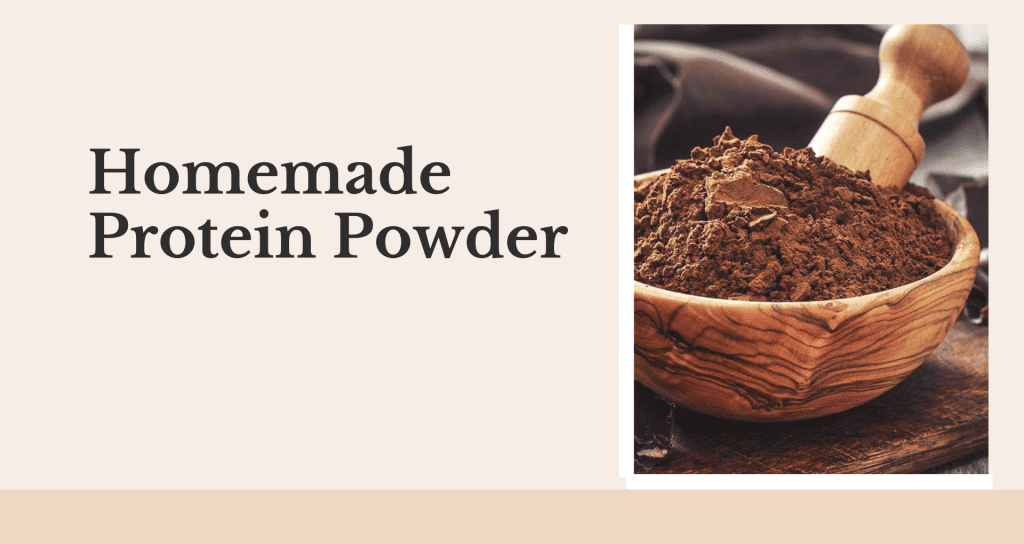Homemade protein refers to protein-rich foods or supplements prepared at home, offering a cost-effective and customizable alternative to commercially available products. The benefits of consuming homemade protein include better control over ingredients, avoiding additives or preservatives, and tailoring the protein source to individual dietary preferences. Additionally, homemade protein allows for a more sustainable and eco-friendly approach, reducing packaging waste associated with store-bought options. Familiar sources of homemade protein include legumes, nuts, seeds, dairy, and lean meats. To make homemade protein, one can blend ingredients into smoothies, create energy bars, or prepare protein-packed meals using whole foods. This approach supports a healthier lifestyle and provides the flexibility to meet specific nutritional needs.
What is Homemade Protein Powder?
Homemade protein powder is a personalized and cost-effective alternative to commercially available protein supplements. It is typically crafted by blending various protein-rich ingredients, such as legumes, nuts, seeds, or dairy, into a fine powder. This DIY approach allows individuals to have greater control over the quality of ingredients, ensuring the absence of additives or preservatives that may be present in store-bought options. Creating homemade protein powder for weight loss allows the blend to be tailored to specific dietary preferences and nutritional requirements. Typical methods involve grinding and mixing the selected ingredients using a blender or food processor, resulting in a versatile protein supplement that can be easily incorporated into smoothies, shakes, or added to meals for an extra protein boost.
Is it Possible to make Protein Powder at Home?
So is it possible to make homemade protein powder? We will tell you how to make protein powder at home. Yes, it is possible to make protein powder at home. Homemade protein powder for weight loss offers the advantage of customization and control over the ingredients, allowing you to create a blend that aligns with your dietary preferences and nutritional goals. Familiar protein sources for homemade powder include legumes (such as lentils or chickpeas), nuts, seeds, and dairy products. You can grind these ingredients into a fine powder using a blender, food processor, or a coffee grinder. The resulting homemade protein powder can be added to smoothies and shakes or used in cooking and baking. While it may not have the same smooth texture as commercially produced protein powders, the benefits of knowing and controlling the ingredients often outweigh this minor difference for those who prefer a DIY approach.
How to make Protein powder at Home?
So how to make protein powder at home? A cheap and flexible approach to make sure you’re getting the protein you need is to make your protein powder. Crafting protein powder at home is simple and rewarding, offering the flexibility to tailor the blend to your preferences. Using a blender or food processor, you can create a personalised protein powder free from additives and preservatives by selecting protein-rich ingredients like legumes, nuts, seeds, or dairy. Here is a straightforward recipe for homemade protein powder for weight loss, complete with information on the time needed, level of complexity, components, and detailed instructions. We will tell you in some simple steps how to make protein powder at home.Also you can check out the Protein Diet Plan for a proper diet plan.
Homemade Protein Powder Recipe
We will give you a simple and easy recipe for how to make protein powder at home-
Time required
This is the time required for homemade protein powder-
- Time to Cook: 20 minutes
- Difficulty Level: Easy
- No. of Serves: Approximately 10 servings
- Nutritional Information (per serving): Varies based on ingredients; typically high in protein and other essential nutrients.
Difficulty
Easy
Ingredients:
- 1 cup of dried beans or legumes (such as chickpeas, lentils, or black beans)
- 1 cup of nuts or seeds (such as almonds, sunflower seeds, or pumpkin seeds)
- 1/2 cup of rolled oats
- 1/2 cup of dried milk powder (optional)
- 1/4 cup of cocoa powder (for chocolate flavor, optional)
- 1/4 cup of sweetener (such as stevia, erythritol, or sugar, optional)
- 1 teaspoon of vanilla extract (optional)
- A pinch of salt,
Using these ingredients you can easily learn how to make protein powder at home and utilize the benefits of homemade protein powder for weight loss. You can also use protein powder for weight loss.
Directions to Make – Step by Step
You can follow these steps and learn how to make protein powder at home-
Step 1- Pick your protein source or sources. Use a coffee grinder or blender to process any nuts or seeds into a fine powder.
Step 2- You can omit this step if your protein source is whey or plant-based. However, if you want to improve the flavor, add flavorings to the blender, such as cocoa powder, vanilla essence, or spices.
Step 3- Add your preferred sweetener to the blender if you want to sweeten your protein powder.
Step 4- Blender with the protein source(s) or nut/seed powder.
Step 5- If desired, improve texture by adding a tiny amount of thickening agent (xanthan gum or guar gum) to the blender. To avoid making the powder too thick, be careful not to add too much.
Step 6- Blend each component until you have a smooth consistency. So that’s how you have learned how to make protein powder at home. Your homemade protein powder is ready. There are many vegan protein sources, you can check out that also.
Benefits of Homemade Protein Powder
Comparing homemade protein powder to protein powders that are sold commercially, there are several benefits. Here are a few advantages:
- If you buy protein sources in bulk, making your protein powder at home may end up being less expensive over time. You can adjust the recipe to fit your budget by selecting inexpensive ingredients.
- Making your protein powder gives you complete control over the substances that go into it. This enables you to stay away from the artificial sweeteners, fillers, and additives that are frequently present in commercial protein powders. You can choose protein sources made from full, high-quality foods.
- If you make your protein powder, you can adjust the ingredients to suit your unique nutritional requirements and tastes. And thus you can utilize the benefits of homemade protein powder for weight loss. If you are looking for a healthy diet, you can check out some healthy recipes.
Can I eat Homemade Protein during Weight Loss?
Certainly! For several reasons, homemade protein can be a valuable addition to your diet during weight loss. Firstly, protein enhances satiety, helping you feel complete for extended periods and reducing overall calorie intake. Homemade protein sources, such as legumes, nuts, seeds, and lean meats, are often nutrient-dense, providing essential vitamins and minerals without excessive calories. This nutrient density ensures you’re meeting your nutritional needs even when cutting back on overall food intake.
Maintaining or increasing protein intake during weight loss is crucial for preserving lean muscle mass. Protein supports muscle repair and growth, and by incorporating homemade protein into your diet, you can help prevent muscle loss, ensuring that the weight you shed comes primarily from fat.
Furthermore, homemade protein offers the advantage of customization and control over ingredients. By avoiding commercially processed protein supplements, you reduce the intake of added sugars, preservatives, and artificial additives that can hinder weight loss efforts. The versatility of homemade protein powder also allows you to create satisfying, low-calorie snacks or meals, supporting your weight loss journey with a nutritious and personalized approach. Well you can check on the details of how much protein is required in the body with the Protein Intake Calculator.
Should I replace Protein Supplements with Homemade Protein Powder?
You can replace protein supplements with homemade protein powder but your particular dietary requirements, preferences, and objectives will determine whether you should switch to homemade protein powder in place of commercial protein supplements. When choosing this choice, keep the following things in mind:
Nutritional Needs: Determine how much protein you need to consume each day. Protein supplements are made to swiftly and easily deliver a concentrated source of protein. Unless correctly designed, homemade protein powder could not have the same amount of protein per serving.
Ingredients: High-quality protein sources like whey, casein, or plant-based proteins are frequently included in commercial protein supplements. Ingredients in homemade protein powder might differ greatly. Homemade options may let you tailor protein powder to your needs if you have particular dietary limitations or allergies. There are many protein rich foods, you can check for them if you are looking for protein consumption.
Expert Review on Homemade Protein Powder
Homemade protein powder is a customizable and cost-effective alternative to commercial supplements. Crafted by blending protein-rich ingredients like legumes, nuts, seeds, or dairy at home, individuals can tailor their nutritional intake according to personal preferences. While lacking the smooth texture of commercial options, homemade protein powder offers the advantage of avoiding additives and preservatives. The process involves grinding selected ingredients into a fine powder, providing a versatile supplement for smoothies, shakes, or as an ingredient in various recipes. It’s a nutritious and wholesome approach that gives individuals greater control over their protein intake, supporting their dietary goals.
References
“Protein Supplements: Pros and Cons.” 2018. PubMed. https://pubmed.ncbi.nlm.nih.gov/28937838/.
FAQs
Can you make protein powder at home?
Yes, homemade protein powder can be easily crafted by blending protein-rich ingredients like legumes, nuts, seeds, or dairy. This DIY approach is a cost-effective and customizable alternative that allows control over additives and preservatives. Blend the selected ingredients into a fine powder, offering a versatile supplement for personalized nutrition in shakes and recipes.
How effective is homemade protein powder?
The effectiveness of homemade protein powder depends on ingredient selection and blending. It can be a cost-effective and nutritious alternative when crafted thoughtfully with protein-rich sources like legumes, nuts, or seeds. However, achieving precise protein content may be challenging, and texture might differ from commercial options, impacting overall effectiveness.
How can I make 100% whey protein at home?
Making 100% whey protein at home involves separating whey from the liquid in yoghurt or milk through straining. Heat milk or yoghurt, add a coagulant like lemon juice, and push the liquid through cheesecloth. The remaining liquid is whey, which can be dried to form a protein powder. However, the process can be time-consuming.
What are the ingredients in Homemade protein powder?
Ingredients for homemade protein powder vary but commonly include legumes (like lentils), nuts (such as almonds), seeds (chia, hemp), and oats. Blend these components into a fine powder using a high-powered food processor. Optionally, cocoa powder can be added for flavour. Adjust quantities based on taste and nutritional preferences.
How much time does it take to make Homemade Protein Powder?
The time to make homemade protein powder depends on the chosen ingredients and the equipment used. Typically, it takes around 20 minutes to prepare and blend the components into a fine powder. This may vary based on the type of nuts, seeds, or legumes selected and the efficiency of the blender or food processor.
How do you make Homemade Protein Powder quickly at home?
For a quick homemade protein powder, combine one cup each of almonds, dried lentils, chia seeds, and hemp seeds in a blender. Add half a cup of dry oats. Blend until an acceptable powder forms. Optionally, mix in one to two tablespoons of cocoa powder for flavour. Store the powder in an airtight container.









